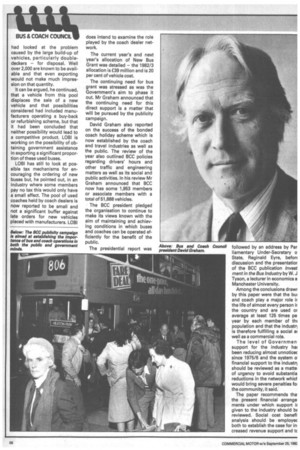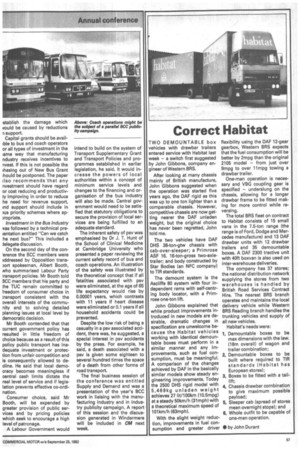BUS & COACH COUNCIL
Page 40

Page 41

If you've noticed an error in this article please click here to report it so we can fix it.
had looked at the problem caused by the large build-up of vehicles, particularly doubledeckers — for disposal. Well over 2,000 are known to be available and that even exporting would not make much impression on that quantity.
It can be argued, he continued, that a vehicle from this pool displaces the sale of a new vehicle and that possibilities considered had included manufacturers operating a buy-back or refurbishing scheme, but that it had been concluded that neither possibility would lead to a competitive product. LOBI is working on the possibility of obtaining government assistance in exporting a significant proportion of these used buses.
LOBI has still to look at possible tax mechanisms for encouraging the ordering of new buses but, he pointed out, in an industry where some members pay no tax this would only have a small effect. The pool of used coaches held by coach dealers is now reported to be small and not a significant buffer against late orders for new vehicles placed with manufacturers. LOBI The current year's and next year's allocation of New Bus Grant was detailed — the 1982/3 allocation is £39 million and is 20 per cent of vehicle cost.
The continuing need for bus grant was stressed as was the Government's aim to phase it out. Mr Graham announced that the continuing need for this direct support is a matter that will be pursued by the publicity campaign.
David Graham also reported on the success of the bonded coach holiday scheme which is now established by the coach and travel industries as well as the public. The review of the year also outlined BCC policies regarding drivers' hours and other traffic and engineering matters as well as its social and public activities. In his review Mr Graham announced that BCC now has some 1,953 members or associate members with a total of 51,888 vehicles.
The BCC president pledged the organisation to continue to make its views known with the aim of maintaining and achieving conditions in which buses and coaches can be operated efficiently for the benefit of the public.
The presidential report was
Council followed by an address by Par liamentary Under-Secretary o State, Reginald Eyre, beforo discussion and the presentatior of the BCC publication Invest ment in the Bus Industry by W. J Tyson, a lecturer in economics a Manchester University.
Among the conclusions drawr by this paper were that the but and coach play a major role ir the life of almost every person ir the country and are used or average at least 125 times pe year by each member of th( population and that the industn is therefore fulfilling a social al well as a commercial role.
The level of Governmen support for the industry hal been reducing almost unnoticec since 1975/6 and the system o financial support to the industn should be reviewed as a matte of urgency to avoid substantia reductions in the network which would bring severe penalties fa the community, it said.
The paper recommends tha the present financial arrange ments under which support it given to the industry should Ix reviewed. Social cost benefi. analysis should be employ& both to establish the case for in creased revenue support and tc
[stablish the damage which vould be caused by reductions support.
Capital grants should be availible to bus and coach operators or all types of investment in the .ame way that manufacturing ndustry receives incentives to nvest. If this is not possible the ihasing out of New Bus Grant hould be postponed. The paper rlso recommends that any nvestment should have regard or cost reducing and productivty improving in order to reduce he need for revenue support, Ind support should include in )us priority schemes where ap)ropriate.
investment in the Bus Industry vas followed by a technical preientation entitled "Can we catch he next bus?" This included a ielegate discussion.
On the second day of the conerence the BCC members were iddressed by Opposition transoort spokesman, Albert Booth, Nho summarised Labour Party transport policies. Mr Booth told BCC members that his party and the TUC remain committed to Freedom of consumer choice in transport consistent with the overall interests of the community and to solving detailed planning issues at local level by democratic decision.
Mr Booth contended that that current government policy has resulted in little freedom of choice because as a result of this policy public transport has inadequate investment or protection from unfair competition and is consequently allowed to decline. He said that local democracy becomes meaningless if central cash limits dictate the real level of service and if legislation prevents effective co-ordination.
Consumer choice, said Mr Booth, will be expended by greater provision of public services and by pricing policies which seek to encourage a high level of patronage.
A Labour Government would intend to build on the system of Transport Supplementary Grant and Transport Policies and pro grammes established in earlier legislation, he said. It would in crease the powers of local authorities within a concept of minimum service levels and changes to the financing and organisation of the bus industry will also be made. Central government would need to be satisfied that statutory obligations to secure the provision of local services are being fulfilled to an adequate standard.
The inherent safety of psv was emphasised by Dr J. T. Hunt of the School of Clinical Medicine at Cambridge University who presented a paper reviewing the current safety record of bus and coach operations. An illustration of the safety was illustrated by the theoretical concept that if all fatalities associated with psv were eliminated, at the age of 65 life expectancy would rise by 0.00001 years, which contrasts with 11 years if heart disease were eliminated or 0.1 years if all household accidents could be prevented.
Despite the low risk of being a casualty in a pm/ associated accident, there was, he suggested, a special interest in psv accidents by the press. For example, he said, a death associated with a psv is given some eighteen to several hundred times the space of a death from other forms of road transport.
The final business session of the conference was entitled Supply and Demand and was a presentation of the year's BCC work in liaising with the manufacturing industry and in industry publicity campaign. A report of this session and the discussion generated in Windermere will be included in CM next week.












































